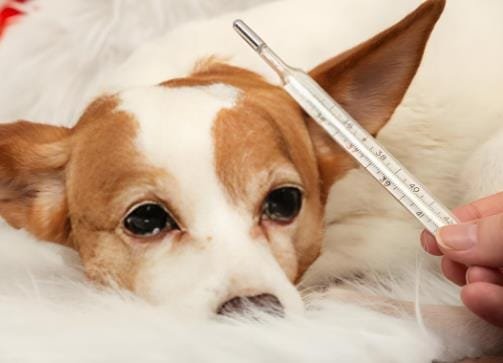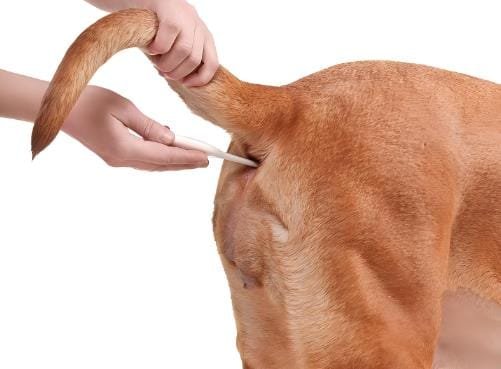
How to Check Your Dog’s Body Temperature
First, you should have the right supplies. A digital thermometer, some lubricant like petroleum jelly, maybe some treats to keep the dog calm. Also, having someone to help hold the dog still might be necessary. I should check if the thermometer is specifically for pets or if a human one works. Probably, any digital thermometer would do, but maybe pet ones have a flexible tip or a quicker read time.
Next, preparing the dog. They might be nervous, so calming them down is important. Maybe do this when they’re relaxed, not after exercise. The steps would be: lubricate the thermometer tip, gently lift the tail, insert the thermometer into the rectum about an inch, wait for the beep, then read the temperature. Wait, how deep should it go? Maybe 1-2 inches? And how long? Digital ones beep when done, so maybe a minute or less.
Normal temperature range for dogs is higher than humans. I think it’s around 101 to 102.5 degrees Fahrenheit. If it’s above 103, that’s a fever, and below 99 could be hypothermia. But I should double-check those numbers. Also, factors like activity or stress can affect the temp, so maybe wait if the dog was active.
Alternative methods: ear thermometers? I’ve heard they can be used but might not be as accurate. Or maybe temporal artery thermometers? Not sure. The rectal method is the most reliable. For a dog that’s resistant, maybe the ear is an option, but need to mention that it’s less accurate.
Safety tips: don’t force the thermometer if the dog is too stressed, as it could cause injury. Be gentle. Clean the thermometer after use with alcohol. Also, maybe don’t use the same thermometer for humans afterward. Label it as pet-only.

Signs of fever or hypothermia: lethargy, shivering, loss of appetite, vomiting, etc. If the temperature is abnormal, contact a vet. Don’t give human medications without consulting a vet.
Wait, I should structure this step by step. Maybe list the supplies needed, preparation steps, the procedure, interpreting results, alternatives, and safety tips. Also, emphasize when to contact a vet. Make sure to mention that if you’re unsure, it’s best to get professional help. Also, maybe mention that checking temperature isn’t the only sign of illness, so look for other symptoms too.
Possible mistakes: inserting the thermometer too roughly, misreading the temperature, not lubricating enough causing discomfort, using a rectal thermometer in the mouth or vice versa. Also, not holding the dog securely leading to injury. Need to stress being gentle and calm.
Another thought: maybe some dogs have a temperature that’s slightly outside the normal range but are fine, so context matters. But generally, the standard range is important. Also, puppies might have different norms? Or is it the same as adult dogs? Probably same, but not sure. Maybe just stick to the general range.
So, putting it all together, the steps would be:
1. Gather supplies: digital thermometer, lubricant, treats, maybe a helper.
2. Calm the dog, maybe have someone hold them.
3. Lubricate the thermometer tip.
4. Lift the tail gently and insert the thermometer about an inch into the rectum.
5. Hold it in place until it beeps (usually 30-60 seconds).
6. Remove and read the temperature.
7. Clean the thermometer and reward the dog.
Then explain normal range, what’s abnormal, and when to call the vet. Also, mention alternatives if rectal isn’t possible, but note they’re less accurate.
Need to check if the insertion depth is correct. Maybe 1 inch for small dogs, up to 2 for larger ones? Or just 1 inch in general. Also, perhaps the thermometer should be inserted slowly and at a slight angle? Not sure. Maybe just straight in gently.
Another thing: the dog’s posture. Maybe standing or lying on their side. Standing might be easier for access. But the person should position the dog comfortably.
Also, after taking the temperature, watch for any signs of distress in the dog. If they seem hurt, consult the vet.
I think that covers the main points. Let me structure this into a clear guide with steps, tips, and precautions.

How to Check Your Dog’s Body Temperature: A Step-by-Step Guide
Supplies Needed:
Digital thermometer (preferably pet-specific for safety and comfort)
Lubricant (e.g., petroleum jelly or water-based lubricant)
Treats (to reward calm behavior)
Gloves (optional, for hygiene)
Alcohol wipes (to clean the thermometer afterward)
Helper (optional, to soothe and hold the dog)
Procedure:
Prepare the Environment:
Choose a quiet area to minimize stress.
Ensure your dog is calm. Avoid taking temperature after exercise or during high excitement.
Position Your Dog:
Have your dog stand or lie on their side. A helper can gently hold their head and torso to prevent movement.
Prepare the Thermometer:
Turn on the digital thermometer and lubricate the tip (1/2 to 1 inch for small dogs; up to 1.5 inches for larger breeds).
Insert the Thermometer:
Lift the tail gently and insert the thermometer into the rectum slowly and at a slight angle (no more than 1-2 inches deep).
Hold the thermometer in place until it beeps (typically 30–60 seconds).
Read and Record the Temperature:
Remove the thermometer and check the reading. Normal range: 101°F to 102.5°F (38.3°C to 39.2°C).
Temperatures above 103°F (39.4°C) indicate a fever; below 99°F (37.2°C) suggests hypothermia.
Post-Procedure Care:
Clean the thermometer with alcohol and reward your dog with treats and praise.
Monitor your dog for any signs of discomfort.
Alternative Methods (Less Accurate):
Ear Thermometers: Use a pet-specific infrared ear thermometer, but ensure proper placement in the ear canal.
Temporal Artery Thermometers: Scan the inner thigh or armpit, but results may vary.
Safety Tips:
Avoid Stress: If your dog resists, stop and consult a vet instead of forcing it.
Hygiene: Use a dedicated thermometer for your pet and clean it thoroughly.
Check for Symptoms: Fever or hypothermia often accompany lethargy, shivering, or loss of appetite. Contact a vet if abnormal temperatures persist.
When to Call the Vet:
Fever (over 103°F/39.4°C) or hypothermia (under 99°F/37.2°C).
Persistent symptoms like vomiting, diarrhea, or labored breathing.
Uncertainty about the reading or procedure.
Note: Rectal thermometry is the gold standard. Always prioritize your dog’s comfort and safety, and consult a professional if unsure. Regular wellness checks help track baseline health!
American Dingo animal behavior Budget Tips canine behavior Canine Care Canine Health DIY pet projects dog behavior Dog Breeds dog care Dog Care Tips dog exercise Dog Food Dog Grooming dog health Dog Measurement dog nutrition dog ownership dog potty area Dog Training Dog Wound Care Family Pets Hunting Dogs lipomas in dogs newborn puppy care obedience training outdoor pet care Pet Care Pet Care Tips Pet Health Pet Loss Pet Safety pet tips pet training Positive Reinforcement Potty Training Puppy Care puppy health Puppy Training Rabies in Dogs Temperature Monitoring Training Tips veterinary advice Veterinary Care Veterinary Tips
-
 Daylight Saving Time & Dogs: Vet-Reviewed Effects on Canine Sleep, Behavior & Adjustment Tips
3 views
Daylight Saving Time & Dogs: Vet-Reviewed Effects on Canine Sleep, Behavior & Adjustment Tips
3 views -
 How to Identify an Australian Stumpy Tail Cattle Dog
3 views
How to Identify an Australian Stumpy Tail Cattle Dog
3 views -
 12 Must-Know 2025 Australia Pet Insurance Stats: Cost Shocks, Gen Z Trends & Vet Bill Survival Guide
2 views
12 Must-Know 2025 Australia Pet Insurance Stats: Cost Shocks, Gen Z Trends & Vet Bill Survival Guide
2 views -
 Labradoodle vs. Cockapoo: Understanding the Differences
2 views
Labradoodle vs. Cockapoo: Understanding the Differences
2 views -
 How to Teach Your Dog to Use the Restroom at a Designated Location
2 views
How to Teach Your Dog to Use the Restroom at a Designated Location
2 views -
 Caring for a Sensitive Dog: 11 Vet-Approved Strategies to Manage Anxiety & Build Trust (2025 Guide)
2 views
Caring for a Sensitive Dog: 11 Vet-Approved Strategies to Manage Anxiety & Build Trust (2025 Guide)
2 views -
 Dog Breeding Age Guide 2025: Optimal Timing for Females & Males (+ Vet-Approved Risks)
2 views
Dog Breeding Age Guide 2025: Optimal Timing for Females & Males (+ Vet-Approved Risks)
2 views -
 UK Pet Industry 2025: 15 Eye-Opening Stats Every Pet Lover Should Know
2 views
UK Pet Industry 2025: 15 Eye-Opening Stats Every Pet Lover Should Know
2 views -
 13 Must-Know 2025 Pet Hotel Stats: Market Boom, Profit Margins & Future Trends Revealed
2 views
13 Must-Know 2025 Pet Hotel Stats: Market Boom, Profit Margins & Future Trends Revealed
2 views -
 What It’s Really Like to Travel with a Guide Dog
1 view
What It’s Really Like to Travel with a Guide Dog
1 view










Leave a Reply
You must be logged in to post a comment.